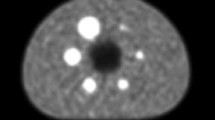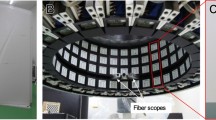Abstract
Objective
Positron emission tomography (PET) scans of imaging receptors require 60–90-min dynamic acquisition for quantitative analysis. Head movement is often observed during scanning, which hampers the reliable estimation of quantitative parameters. This study evaluated image-based motion correction by frame-to-frame realignment for PET studies with [11C]raclopride and [11C]FLB 457 acquired by an Eminence SET-3000GCT/X and investigated the effect of this correction on the quantitative outcomes.
Methods
First, an optimal method for estimating motion parameters was evaluated by computer simulation. Simulated emission sinograms were reconstructed to the PET images with or without attenuation correction using a µ-map of the transmission scan. Six motion parameters were estimated frame-by-frame by registering each frame of the PET images to several types of reference images and the reliability of registration was compared. Next, in [11C]raclopride and [11C]FLB 457 studies in normal volunteers, six motion parameters for each frame were estimated by the registration method determined from the simulation results. Head movement was corrected by realigning the PET images reconstructed with a motion-included µ-map in which a mismatch between the transmission and emission scans was corrected. After this correction, time-activity curves (TAC) for the striatum or cerebral cortex were obtained and the binding potentials of the receptors (BPND) were estimated using the simplified reference tissue model.
Results
In the simulations, the motion parameters could be reliably estimated by registering each frame of the non-attenuation-corrected PET images to their early-phase frame. The motion parameters in the human studies were also obtained using the same method. After correction, a discontinuity of TACs in the striatum and cerebral cortex was remarkably improved and the BPND values in these regions increased. Compared to the motion-corrected PET images reconstructed using the measured µ-map, the images reconstructed using the motion-included µ-map did not result in a remarkable improvement of BPND in the striatum of [11C]raclopride studies, while the BPND in the cerebral cortex changed in some [11C]FLB 457 studies in which large head movement was observed.
Conclusions
In PET receptor imaging, head movement during dynamic scans can be corrected by frame-to-frame realignment. This method is easily applicable to clinical studies and provides reliable TACs and BPND.









Similar content being viewed by others
References
Farde L, Ehrin E, Eriksson L, Greitz T, Hall H, Hedstrom CG, et al. Sub-stituted benzamides as ligands for visualization of dopamine receptor binding in the human brain by positron emission tomography. Proc Natl Acad Sci USA. 1985;82:3863–7.
Farde L, Eriksson L, Blomquist G, Halldin C. Kinetic analysis of central [11C]Raclopride binding to D2-dopamine receptors studied by PET—a comparison to the equilibrium analysis. J Cereb Blood Flow Metab. 1989;9:696–708.
Halldin C, Farde L, Hogberg T, Mohell N, Hall H, Suhara T, et al. Carbon-11-FLB 457: a radioligand for extrastriatal D2 dopamine receptors. J Nucl Med. 1995;36:1275–81.
Farde L, Suhara T, Nyberg S, Karlsson P, Nakashima Y, Hietala J, et al. A PET- study of [11C]FLB 457 binding to extrastriatal D2-dopamine receptors in healthy subjects and antipsychotic drug-treated patients. Psychopharmacology. 1997;133:396–404.
Delforge J, Bottlaender M, Loc'h C, Guenther I, Fuseau C, Bendriem B, et al. Quantitation of extrastriatal D2 receptors using a very high-affinity ligand (FLB 457) and the multi-injection approach. J Cereb Blood Flow Metab. 1999;19:533–46.
Olsson H, Halldin C, Swahn CG, Farde L. Quantification of [11C]FLB 457 binding to extrastriatal dopamine receptors in the human brain. J Cereb Blood Flow Metab. 1999;19:1164–73.
Suhara T, Sudo Y, Okauchi T, Maeda J, Kawabe K, Suzuki K, et al. Extrastriatal dopamine D2 receptor density and affinity in the human brain measured by 3D PET. Int J Neuropsychopharmacol. 1999;2:73–82.
Herzog H, Tellmann L, Fulton R, Stangier I, Rota Kops E, Bente K, et al. Motion artifact reduction on parametric PET images of neuroreceptor binding. J Nucl Med. 2005;46:1059–65.
Montgomery AJ, Thielemans K, Mehta MA, Turkheimer F, Mustafovic S, Grasby PM. Correction of head movement on PET studies: comparison of methods. J Nucl Med. 2006;47:1936–44.
Mourik JE, Lubberink M, van Velden FH, Lammertsma AA, Boellaard R. Off-line motion correction methods for multi-frame PET data. Eur J Nucl Med Mol Imaging. 2009;36:2002–133.
Costes N, Dagher A, Larcher K, Evans AC, Collins DL, Reilhac A. Motion correction of multi-frame PET data in neuroreceptor mapping: simulation based validation. Neuroimage. 2009;47:1496–505.
Wardak M, Wong KP, Shao W, Dahlbom M, Kepe V, Satyamurthy N, et al. Movement correction method for human brain PET images: Application to quantitative analysis of dynamic 18F-FDDNP scans. J Nucl Med. 2010;51:210–8.
Goldstein SR, Daube-Witherspoon M, Green MV, Eidsath A. A head motion measurement system suitable for emission computed tomography. IEEE Trans Med Imaging. 1997;16:17–27.
Bloomfield PM, Spinks TJ, Reed J, Schnorr L, Westrip AM, Livieratos L. The design and implementation of a motion correction scheme for neurological PET. Phys Med Biol. 2003;48:959–78.
Rahmin A. Advanced motion correction method in PET. Iran J Nucl Med. 2005;13:1–17.
Picard Y, Thompson CJ. Motion correction of PET images using multiple acquisition frames. IEEE Trans Med Imaging. 1997;16:137–44.
Jin X, Mulnix T, Planeta-Wilson B, Gallezot JD, Carson RE. Accuracy of head motion compensation for the HRRT: comparison of method. IEEE Nucl Sci Conf Rec. 1997.
Andersson JL, Vagnhammar BE, Schneider H. Accurate attenuation correction despite movement during PET imaging. J Nucl Med. 1995;36:670–8.
Yamada M, Uddin LQ, Takahashi H, Kimura Y, Takahata K, Kousa R, et al. Superiority illusion arises from resting-state brain networks modulated by dopamine. Proc Natl Acad Sci USA. 2013;110:4363–7.
Matsumoto K, Kitamura K, Mizuta T, Tanaka K, Yamamoto S, Sakamoto S, et al. Performance characteristics of a new 3-dimensional continuous-emission and spiral-transmission high-sensitivity and high-resolution PET camera evaluated with the NEMA NU 2–2001 standard. J Nucl Med. 2006;47:83–90.
Lammertsma AA, Hume SP. Simplified reference tissue model for PET receptor studies. Neuroimage. 1996;4:153–8.
Kuhar M, Murrin C, Malouf A, Klemm N. Dopamine receptors in vivo: the feasibility of autoradiographic studies. Life Sci. 1978;22:203–10.
Martres MP, Bouthenet ML, Sales N, Sokoloff P, Schwarts JC. Widespread distribution of brain dopamine receptors evidenced with (125I)iodosulpiride, a highly selective ligand. Science. 1985;228:752–4.
Catana C, Benner T, van der Kouwe A, Byars L, Hamm M, Chonde DB, et al. NRI-assisted PET motion correction for neurologic studies in an integrated MR-PET scanner. J Nucl Med. 2011;52:154–61.
Ullisch MG, Scheins JJ, Weirich C, Rota Kops E, Celik A, Tellmann L, et al. MR-based PET motion correction procedure for simultaneous MR-PET neuroimaging of human brain. PLoS ONE. 2012;7:e48149.
Chen KT, Salcedo S, Chonde DB, Izquierdo-Garcia D, Levine MA, Price JC, et al. MR-assisted PET motion correction in simultaneous PET/MRI studies of dementia subjects. J Magn Reson Imaging. 2018;48:1288–96.
Acknowledgements
We thank the staff of the clinical research support section, the clinical neuroimaging team, and the radiopharmaceutical production team at the National Institute of Radiological Sciences QST for their assistance in conducting the PET studies and Dr. Keisuke Matsubara at the Research Institute for Brain and Blood Vessels Akita for his suggestion regarding the image analysis. We also thank Drs. Keishi Kitamura and Tetsuro Mizuta at the Shimadzu Corporation for their support in the data processing of the reconstruction.
Author information
Authors and Affiliations
Corresponding author
Ethics declarations
Conflict of interest
The authors declare that they have no conflict of interest.
Additional information
Publisher's Note
Springer Nature remains neutral with regard to jurisdictional claims in published maps and institutional affiliations.
Rights and permissions
About this article
Cite this article
Ikoma, Y., Kimura, Y., Yamada, M. et al. Correction of head movement by frame-to-frame image realignment for receptor imaging in positron emission tomography studies with [11C]raclopride and [11C]FLB 457. Ann Nucl Med 33, 916–929 (2019). https://doi.org/10.1007/s12149-019-01405-1
Received:
Accepted:
Published:
Issue Date:
DOI: https://doi.org/10.1007/s12149-019-01405-1




